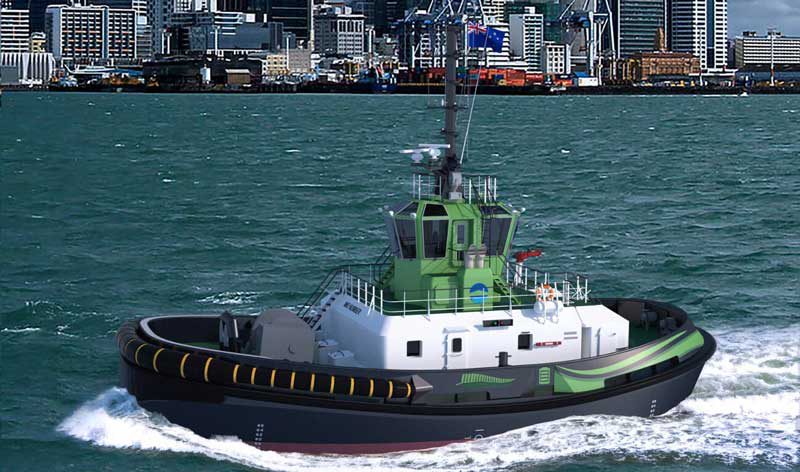Ports of Auckland, the company which administers the freight and cruise ship harbour facilities for New Zealand’s largest city, announced on Monday that it has signed a contract with Dutch shipbuilding and engineering conglomerate Damen Shipyards to buy the world’s first full-sized, fully electric port tugboat.
The new tug – a Damen RSD-E Tug 2513 to be delivered in 2021 – will boast a 70-tonne bollard pull, the same as the Ports of Auckland’s strongest diesel tug, Hauraki, which was also built by Damen. Unlike a diesel tugboat, however, the coast of operating an electric tug is less than a third of the cost when compared to a diesel tug.
The Ports of Auckland began investigating the role of electric, battery-powered tug’s back in 2016 when they made their commitment to be powered by zero emissions by 2040.
“In 2016 we set ourselves the goal of being zero emission by 2040,” said Tony Gibson, CEO of Ports of Auckland in a statement to the press.
“We set this goal because we recognise that urgent action is needed on climate change, and we wanted to be part of the solution. However, setting that goal created a tough challenge. We have a lot of heavy equipment, like tugs, and in 2016 there were no zero emission options.”
https://youtu.be/wSX97HnsQxw
While there is another electric tug under construction for use in Turkey, it is a smaller tug designed with a conventional twin-screw propulsion line (as opposed to the Azimuth propulsion in the newly-announced RSD-E 2513) and is intended to work in a very narrow and tight environment.
Thus, the new Ports of Auckland tug will go down as the world’s first full-sized electric tug.
More specifically, the new tug is an electric version of the existing Damen RSD Tug 2513 – Damen Shipyards’ greenest diesel tug and is being billed as the company’s next-generation of harbour tugboats. As such, the tug is designed to be able to fulfil all the requirements of any normal tug.
“It was important to us that a new electric tug should be able to carry out normal port operations, just like our existing diesel tugs,” said Gibson.
“Our new e-tug will be able to do three to four shipping moves on a full charge, or around three to four hours work (one shipping move takes an hour on average). A fast charge will take about two hours. This is just what we need.
“One of the other hurdles we had to get over was cost. The purchase price of this tug is significant, at roughly double that of a diesel tug, and that is an important consideration for a business that needs to make a profit.
“However, we are prepared to wear that up-front cost because our commitment to reduce emissions has to be more than just words.”
The RSD-E 2513 has two 1000 kW diesel back-up generator sets – allowing the tug to operate at 40 tonnes bollard pull in the event of an electrical system failure or if the vessel needs to operate for a longer duration – but Damen Shipyards is quick to point out that this new electric tug is not a hybrid tug and that, under normal operating conditions and circumstances, the backup generators will not be necessary.
While the cost of the new electric tugboat will cost twice as much as a diesel tug, the price includes the cost of the necessary charging infrastructure and, over the 25-year lifespan of the tug, Ports of Auckland will save 25 years’ worth of diesel pollution and a net reduction in costs of around $2.5 million as it becomes cheaper to operate.
Over the life of the tug, Ports of Auckland expects to save around $12 million in operating costs, “making our electric tug cheaper in the long-term,” added Tony Gibson.
“People who say we have to wait for the technology to emerge before we can set ourselves bold goals have got it round the wrong way,” said James Shaw, New Zealand Minister for Climate Change. “Many of the challenges we face with climate change will require solutions that aren’t yet on the market.
Ports of Auckland and an increasing number of other businesses across New Zealand are showing that won’t stop them finding ways to meet our goals on greenhouse gas emission reductions.”
Joshua S. Hill is a Melbourne-based journalist who has been writing about climate change, clean technology, and electric vehicles for over 15 years. He has been reporting on electric vehicles and clean technologies for Renew Economy and The Driven since 2012. His preferred mode of transport is his feet.

